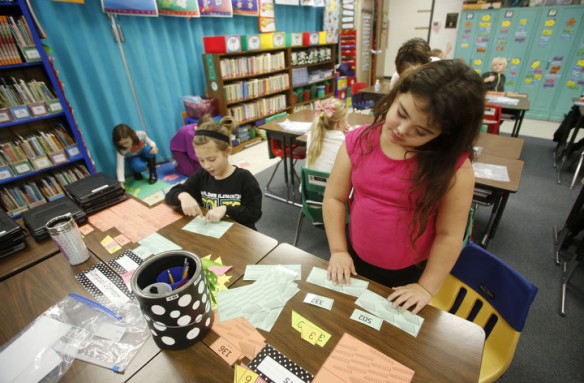
Second-grade students Allie Grubb and Georgia Banfield match numbers with their visual representations during Amy Orberson’s class at at Woodlawn Elementary School (Boyle County).
Photo by Amy Wallot, Dec. 2, 2014
By Brenna R. Kelly
Brenna.kelly@education.ky.gov
If listening to students talk about mathematics brings a smile to a math teacher’s face, hearing students figure out mathematics concepts on their own is music to their ears. This year, teachers at Woodlawn Elementary School are hearing a lot of music.
The Boyle County school started using formative assessment lessons (FAL) in hopes of deepening students’ understanding of math concepts and how to use them.
The lessons are part of the Math Design Collaborative, which provides teachers with tools to help them know whether their students are learning, and if they’re not, to adjust their lessons.
“As teachers, you were trained one way, and you have your way of teaching it, and you have your own biases and your own preset ideas about what kids are going to do and how they learn,” said Bernice Bates, Woodlawn’s principal. “What this FAL does is open teachers’ eyes to the misconceptions students have, and then to what they need to do to change their instruction to meet the needs of kids.”
Renee Yates, a Kentucky Department of Education instructional specialist who provides MDC support for the state, said it works like this:
After teaching about two-thirds of a math unit of study, the teacher stops. Students take a quick assessment and the teacher analyzes the student work, sorting it into groups based on students’ like understanding.
“If you see a group of kids that are totally off target, those kids go in a stack,” she said. “If you have kids that have totally mastered the content, they go into a different stack.”
The teacher then meets with another teacher and together they look for trends in the work.
“Then the teachers work to form feedback questions to move kids forward in their thinking,” she said. Instead of re-teaching the concept, the idea is for teachers to ask questions that will help students figure out the concepts on their own by thinking critically and discussing them with their peers.
To make that happen, a student is paired with another student who has the same misconception for an activity. Many of the activities are collaborative card-sorting exercises in which students have to match cards that show several ways of solving a problem.
That’s when the music begins to play.
“When you see kids working in the card sort activities they are excited and they are having fun, and talking about math,” Yates said.
Students with the same misconceptions are put together so that a student who understands the concept doesn’t just explain it.
“We want students to learn from each other at their own pace,” she said. “We want them to figure it out for themselves.”
To facilitate that productive struggle, teachers ask questions that can help the students think more deeply about the concept.
Discussing mathematics is a way to increase students’ understanding of math concepts, according to several studies cited by the National Council of Teachers of Mathematics. That deeper understanding can be lost when students are taught to simply follow a procedure. Being able to use arguments and critique other students’ reasoning is also called for in the Kentucky Core Academic Standards under Standards for Mathematical Practice.
Woodlawn teacher Tonya Lynch heard those conversations when she used a FAL lesson with her 4th-grade students. The students were trying to match cards that showed several ways of doing double-digit multiplication. The cards do not give the answer to problems so that the students focus on the how and why, not the result.
“I liked the discussions they had with each other,” she said. “They would justify why they thought this one went with the other one.”
Second-grade teacher Amy Orberson’s students participated in an activity about place value.
“No matter what level they were at, they were able to participate in the conversation,” she said. “They were able to explain their thinking to their peers.”
That’s what’s expected of students today, she said.
“I liked the formative assessment lessons because it really encourages student-led learning,” she said. “That’s what expected in this day and time, the kids are supposed to lead the discussions.”
Both teachers said that when the students were paired with like peers, the groups could all work at a different pace – some got through only a few tasks, while others finished all of the card sets, she said.
“One group I could give minimal hints to and they just kept moving; with other groups I could be a little more specific and say, ‘Well, how many ones are here and do you see a picture that matches that same number of ones?’ ” Lynch said.
During the activity, the teacher is supposed to ask questions to keep the students moving and take notes about their understanding, but she not does teach the concept, Yates said.
Lynch explained it to her students this way: “I’m sort of the facilitator, but I’m not teaching it to you, you’re responsible for thinking outside the box.”
After the card sort, the teacher leads a class discussion in which students explain their work. Students then take the same assessment and the teachers meet again to see what worked and how the math concept could be taught differently next year.
Then the teacher goes on with the rest of the lesson.
FAL lessons from the MDC have been used in middle and high schools across the state through support from the Bill & Melinda Gates Foundation, Yates said.
But there were no lessons for elementary teachers, so Kentucky educators decided to write their own.
“A few of us at KDE working in small groups wrote these lessons and spent lots and lots of time getting feedback from teachers and improving them,” she said.
The lessons for kindergarten through 5th grade that the KDE mathematics instructional specialists wrote can be found on Yates’ website and in KDE’s Continuous Instructional Improvement Technology System (CIITS).
Yates has trained teachers in districts across the state. She came to Woodlawn Elementary after Bates realized that student achievement in mathematics was lagging behind other content areas at the high-performing school.
Bates said she believed the free resource would help energize the schools’ math instruction. The teachers now have at least two FAL lessons per grade level.
So far, the results – gauged by the district’s common assessments – are just what she expected.
“The common assessment data showed that these 2nd-graders really knew place value and that the teachers had done a good job with that,” Bates said.
Yates said a few elementary schools are using the lessons but she hopes that the number will grow because of how well they seem to help students understand math concepts.
“It’s just good teaching, basically,” she said. “It’s just really effective teaching.”
MORE INFO …
Renee Yates Renee.yates2@education.ky.gov
Bernice Bates Bernice.Bates@boyle.kyschools.us
Amy Orberson Amy.Orberson@boyle.kyschools.us
Tonya Lynch Tonya.Lynch@boyle.kyschools.us




[…] Kelly, B. (2015, January 13). A new approach to teaching mathematics. (Kentucky Department of Education). Retrieved September 16, 2017, from Kentucky Teacher: http://www.kentuckyteacher.org/features/2015/01/a-new-approach-to-teaching-mathematics/ […]